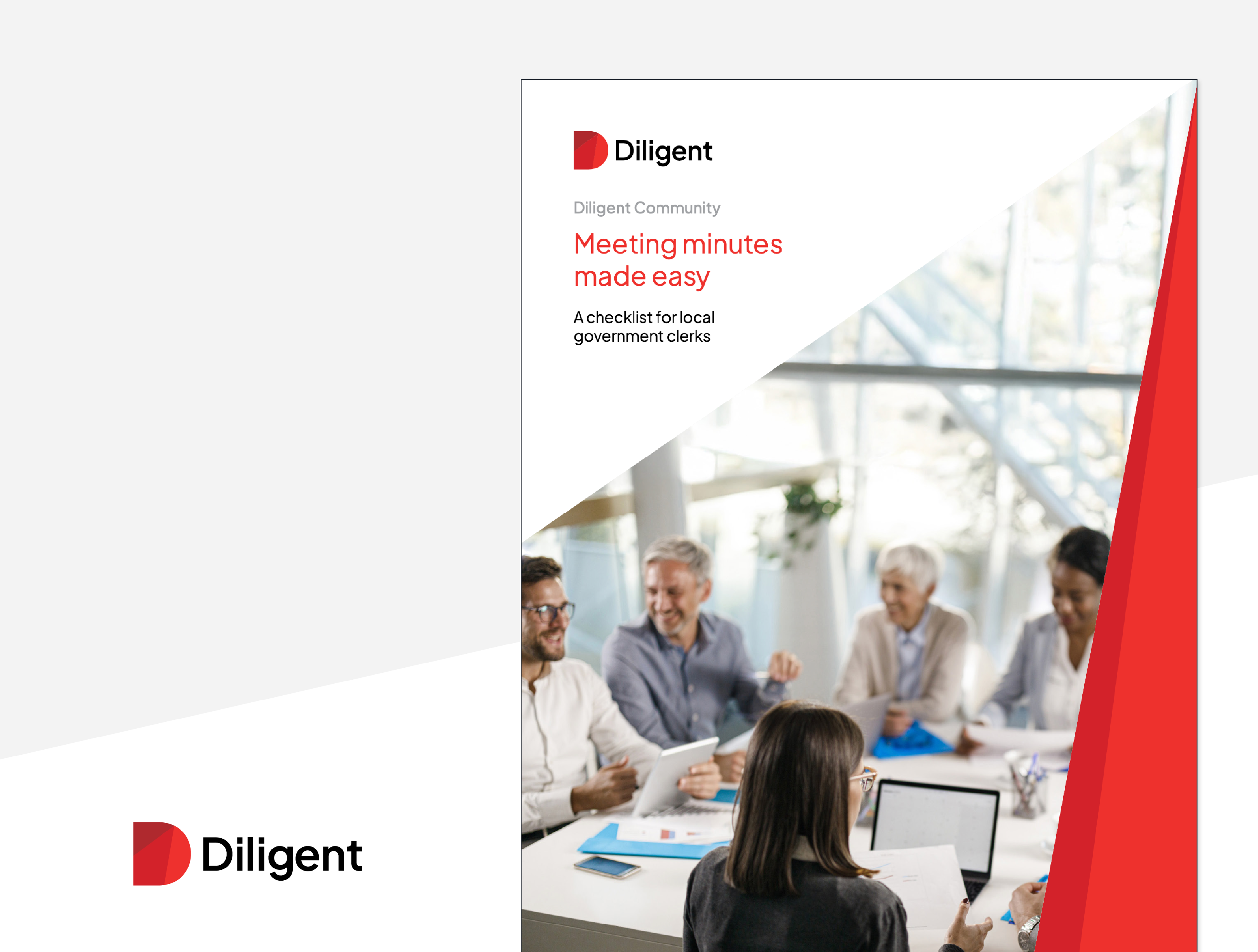A day in the life of a local government clerk

New parks, zoning changes and business ribbon cuttings: the public sees the results of city council action all the time. They may not, however, know who is behind the work. Effective city council meetings don’t happen by accident.
It’s the local government clerk who keeps everything moving. They are responsible for so many of the tasks crucial to the council's ability to govern and the city's ability to serve its residents.
Let’s take a closer look at a (fictional) local government clerk’s typical day for insight into how this pivotal role plays a part in the council’s work and local quality of life.
7:15 a.m. Kerry Smith turns into the city hall parking lot and gets a great space at this time of the morning. There’s a little buffer before the hall doors open and today’s visitors start streaming in; it’s a great time of the day to get ahead of her work. She emerges from the car holding her laptop bag in one hand and a travel mug of coffee in the other.
Walking to the front door, she already has a good sense of what to expect. The city council meeting is tonight, so she is prepared for a long day with a lot of moving parts. As the city clerk, Kerry plays an essential role in preparing for and managing the meeting. She makes sure city leaders and staff have all the information they need to ensure the meeting runs smoothly and the council can make informed decisions.
She also maintains transparency while keeping the public informed about the council’s actions and ensures the city is complying with state open meetings laws and other procedures and requirements mandated by law.
7:30 a.m. After chatting for a few minutes with the front desk receptionist and other coworkers, Kerry heads to her desk and checks her calendar and email. A council member is seeking clarification on an amendment to a bylaw for tonight’s meeting. The parks and recreation director is inquiring about whether new information on costs is reflected in the updated budget. A local journalist has submitted a Freedom of Information Act request about last month’s meeting. Kerry replies, directing them to the city’s public transparency website where they can review all past open session meetings and minutes. Thankfully, that goes quickly.
[quote image] "Transparency is about building trust within our community. By providing information at their fingertips, we empower our citizens to engage and stay informed about city activities." Gladis Sanchez, City Secretary, City of Pearland
Kerry creates a checklist to prioritize her tasks, including starting work on updating the strategic plan following the council’s directives.
10 a.m. Her travel mug now empty, Kerry joins a meeting with the city manager about upcoming items for next month's meeting, including some zoning changes and budget development for next year. Although the items are relatively straight-forward, there is a lot of information, and it will take a collaborative effort to build. She knows that she can take advantage of the Workflow feature that accompanies the board solution’s agenda building feature to add items that need to go on next month’s agenda. She’ll post them to their board management software for the members to read before the next meeting.
Noon. It’s not a great day for a lunch break. Kerry and a couple of colleagues order lunch so she has some wiggle room to ensure she is ready for tonight’s meeting. She must also begin the preparation process for the next meeting. It’s on her to prepare minutes that accurately reflect the council’s discussions and decisions, so Kerry gets her meeting minutes template ready. Once tonight’s meeting is done, she’ll finalize the minutes for the council to approve at the next meeting, and these will be posted to the city’s secure website, making them accessible and searchable to the public.
Transform your role as clerk
Discover practical strategies and key tools to improve board effectiveness, enhance security and transparency. Take the first step to a more efficient and transparent government.
Download the checklist!1 p.m. Kerry meets with two new council members and conducts a brief training on the board management software. She walks them through how to access documents, use the search feature, conduct online voting and review charters as well as other pertinent information located in the library. Kerry enjoys the chance to work directly with council members. Being a resource and helping council members feel confident in their roles are among her favorite parts of the job.
Kerry confirms again that the agenda is accessible to the public. She enthusiastically takes advantage of the Public Release Delay setting in her board management software based on her state's open meeting law requirements. The council clerk must stay on top of local, state and federal Open Meeting requirements associated with the city’s public facing meetings. Kerry and her counterparts are on the front line of ensuring the city and the council remain transparent, accessible and compliant.
3:30 p.m. With a council meeting scheduled for 6 p.m., Kerry spends the late afternoon in discussion with IT, Legal and others who have a role in preparing for the meeting. She works with IT to verify that all audio and tech requirements are in place and working, and the livestreaming service is ready to go. She places water bottles and nameplates neatly at each council member’s seat. Kerry remembers when she had to create hard copies, bind and deliver the voluminous meeting packets to each council member. Those days are long over.
5 p.m. Kerry doublechecks the software to see how many people have signed up ahead of time to speak during the public comment period. Depending on the topics discussed, council meetings are usually well attended with community members, business owners and oftentimes the press. She sees several requests to address the council about a contested zoning change and approves those requests, which will in turn automatically become part of her minutes.
After she’s completed preparations, she grabs a quick sandwich and heads back to city hall in time to greet everyone attending the council meeting. She also ensures that any documents that will require signatures post-meeting are ready to go. She’s grateful for the sign and adopt feature on her board management software which provides the option to apply signatures to the minutes directly within the solution.
Looking to enhance the role you play in your city government? Download the Diligent essential guide for local government clerks.
6 p.m. As the meeting begins, Kerry sits at the staff table, laptop open. She takes roll, records minutes and notates voting results. While she takes her own notes, the board software’s AI notetaker is also recording and transcribing the speakers. She’s glad for the AI backup when she attends to a couple of technical issues: a slide presentation that won’t display properly and a muted mic during the public speaking period.
9 p.m. The meeting adjourns. As the council members and staff leave the boardroom, Kerry checks to see that everything is turned off and put away. Maintenance staff come to pick up empty water bottles.
She walks to her car with two of her colleagues and heads home. Tomorrow, she’ll use the meeting minutes template to help write up draft minutes to put in the board management software for the council’s review when the next agenda packet is released and, once approved, subsequent publication to the public website. Kerry is tired but happy after another successful council meeting cycle. It’s good to know she’s making a difference.
Clerks are at the heart of good governance
Clerks like Kerry are the backbone of effective governance. They keep the city compliant, organized and transparent. The clerk’s role is multifaceted and expands a broad range of responsibilities, all essential.
The local government clerk’s recordkeeping helps to protect the city legally. Their agenda preparation and meeting management allow for orderly, productive discussions. Their handling of public records and communications helps maintain the community’s trust. They also play a key role in ensuring policies are kept up to date and made accessible to public stakeholders.
Technology can effectively support the clerk in their role, helping to streamline many of these processes, help them keep their city compliant and on track to meet their strategic goals.
How Diligent Community can help support local government clerks
Diligent Community is a cloud-based software solution specifically designed for local governments. It provides a secure, centralized platform for local government clerks to manage all their tasks. It can save time, improve accuracy and reduce the risk of errors. It enhances administrative processes, streamlines communication and improves overall efficiency for the entire governance team.
We at Diligent understand the role the local governance clerk plays and the many challenges they face throughout their day. We’re here to help. Request a demo of Diligent Community today to see how it can save valuable time while supporting your town.
Keep exploring

Transparency through technology for local government
Learn how to leverage agenda and meeting management software to improve transparency, inclusivity and citizen engagement.

Streamline your meeting minutes: A checklist for local government clerks
Discover how to streamline your meeting minutes with our practical checklist for local government clerks to help enhance efficiency and compliance.

Welcome to the essential guide for local government clerks
Download our guide for local government clerks to gain insights, adaptable strategies and reliable solutions to excel in their crucial role.

Mastering communication with your local government council members
Good communication between the clerk and council members is key to high-quality and efficient governance, and that they contribute effectively to board meetings.
